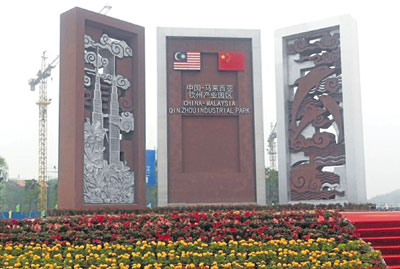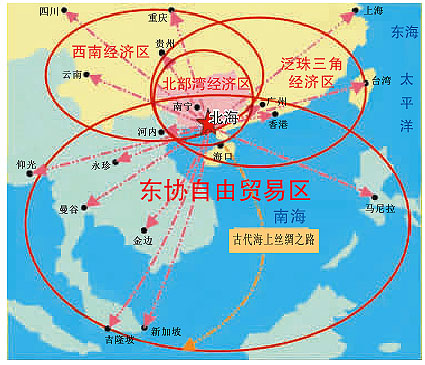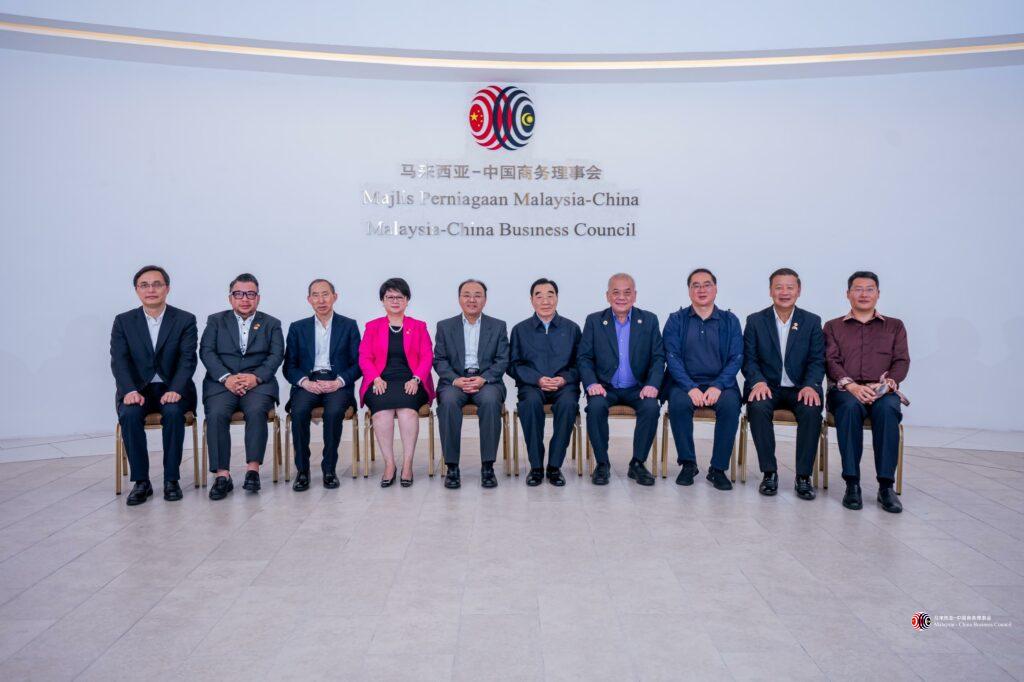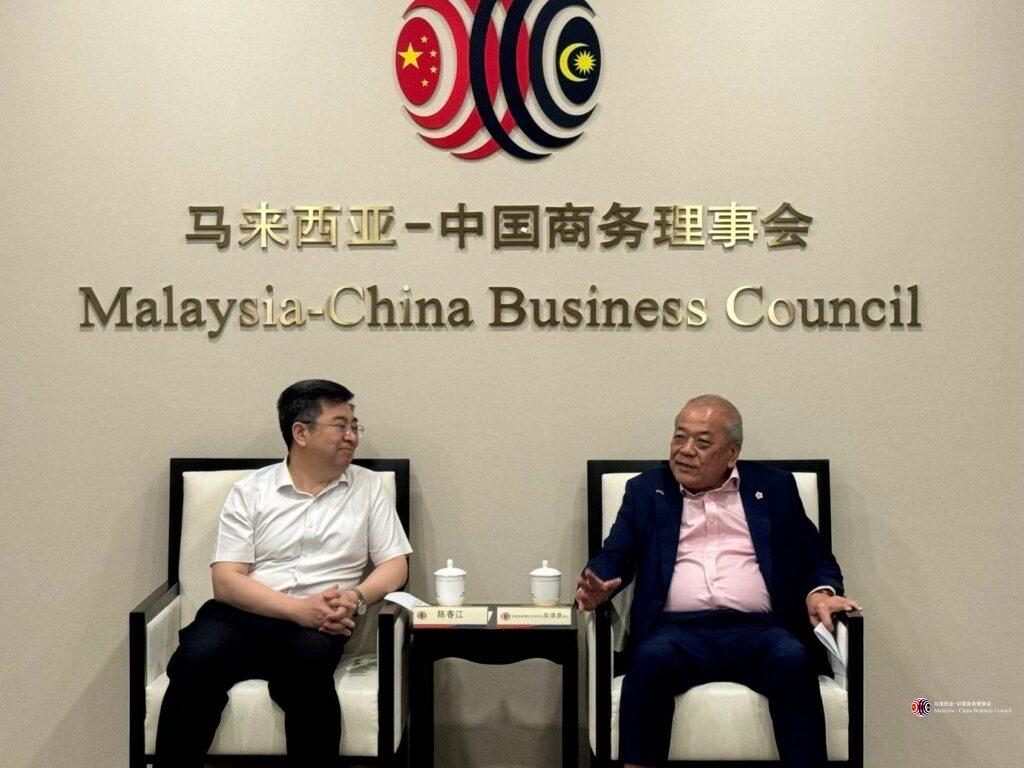等待百年,广西终于等到它的世纪!2010年,东协-中国自由贸易区成立后,位居三大经济圈交会、西南门户的广西,将以“南北钦防”领军北部湾经济区冲刺发展,不但布建以首府南宁为中心的基础建设体系,更重点经营临海进出口的铁三港、及崇左市的边境贸易。种种布局显示,广西,正积极奋起。
碰到任何一个当地官员,几乎每个人都会异口同声地告诉访客,2008年1 月后的北部湾经济区,已经上升为国家的战略,是继珠三角、长三角、渤海湾后,政府欲打造的第四个沿海经济区。
广西北部湾经济区由南宁、北海、钦州、防城港四市所辖行政区域组成,其规划于2008年2 月发布,是中国西部唯一沿海的地区,处于东协-中国自贸区、泛北部湾经济合作区、大湄公河次区域、中越“两廊一圈”、泛珠三角经济区、西南六省(区、市)协作等多个区域合作交汇点。
这里南拥北部湾,背靠大西南,东连珠三角,面向东南亚,西南与越南接壤,是中国沿海与东协国家进行陆上交往的枢纽,是促进中国与东协全面合作的重要桥梁和基地,区位优越,战略地位突出,发展潜力巨大。
从地图上看,有人说这个区域很像一只俯冲的鹰,毗邻粤港澳,面向东南亚,背靠大西南。面积约占广西的五分之一 ,总人口数约1300万。
广西北部湾经济区处于北部湾顶端的中心位置,主要包括南宁市、北海市、钦州市、防城港市所辖区域范围,同时,包括玉林市、崇左市的交通和物流。土地面积4.25万平方公里,海域总面积近13万平方公里,海岸线长1595公。
北部湾经济区内,一个个百亿元、千亿元的工业园区建设热火朝天;南宁、钦州- 防城港、北海、铁山港(龙潭)、东兴(凭祥)5 个组团,活力迸发;以不到广西五分之一的土地、四分之一的人口,北部湾经济区创造了超过全广西三分之一的生产总值和近一半的进出口总额。
2006年末,这里的生产总值合计1439亿元(人民币,下同),仅占广西生产总值的30%。
不到5年翻逾倍
到了今年,中国国家统计局数据显示,上半年首3个月广西北部湾经济区生产总值就达1117.59 亿元,比去年同期增长16.3% ,比全国7.1%的增速高出9.2 个百分点。也就是说,北部湾经济区的经济规模不到5年就翻一倍以上。
2011年,北部湾经济区生产总值3862.33 亿元,同比增长15.9%,6 年年均增长约16%。
钦州、北海、防城港3 市分列广西经济增幅前三名;北部湾港吞吐量1.53亿吨,同比增长30.92%,成为全中国规模以上港口中增长的领头羊。
2010年东协-中国自贸区的成立,更让北部湾经济“孔雀东南飞” ,中国的云贵川渝湘琼粤沪,以及台港澳等地,纷纷“相中”北部湾,来此发展“飞地经济”,合作建设产业园。
北部湾人因势利导,积极探索建设“中国- 东东协地经济试验区”。
在东协-中国自贸区的平台上,北部湾经济区港口、资源、环境、政策等优势深度整合,面向东协、服务西南、中南、华南的辐射带动作用不断被激活。
中央力挺大力发展基建 北部湾 “大动脉”打通
从蓝图初绘到全面建设,从风生水起到千帆竞发,短短几年,经济区已规模初具,北部湾龙腾虎跃!
北海,曾作为中国“海上丝绸之路”的始发港而繁华一时;钦州,曾是孙中山先生《建国方略》中的“南方第二大港”;北海,也曾得改革开放风气之先,1984年被国务院确定为进一步对外开放的14个沿海城市之一……
然而,潮起潮落,一度沉寂不仅是北海,多少年来,广西给外界留下的印象只是一个“老少边山穷”地区。
陆空交通方便
随着中国国家西部大开发战略的实施推进,对外开放力度进一步加大。尤其是近年来,抓住中国-东协自贸区建设的契机,北部湾一跃而起,成为广西经济社会发展新引擎。
南宁埌东新区地王大厦,大西南第一高楼,欣慰地俯瞰着青春焕发、蓬勃成长的邕城。半城绿树半城楼,新楼林立,道路纵横,虹桥飞架,车流如梭。
北部湾经济区内,大道通衢,“同城化”经济区、“1 小时”经济圈呼之欲出。
向外看,通往越南、云南、贵州、湖南、广东的6 条高速公路全部打通,通往广东、湖南、云南的高速铁路加快建设。空中交通更加便捷,南宁、桂林两个区域枢纽机场“双轮驱动”、支线和通用机场“并驾齐驱”,广西已有飞行航线达182 条。投资68亿元的南宁吴圩国际机场新航站区及配套扩建工程,正加紧施工。
贸易额7年猛升近8倍 东协国家抢进广西
北部湾经济区与东协的交流合作也日趋深化。2011年,广西与东协的贸易额达到95.6亿美元(约301亿令吉),东协已连续13年成为广西最大的贸易伙伴。
目前,东协10国已有5 国在南宁设总领馆。2011年,广西与东协诸国的贸易额为2005年的7.8 倍,与东协诸国的进出口规模居西部12省区市之首。
作为跨境贸易人民币结算试点省区,广西至2011年底累计办理跨境人民币结算业务突破500亿元,居全国8 个边境省区首位。
东协-中国博览会、泛北部湾论坛、东协龙舟赛、南宁国际民歌艺术节,东协国际商务区、马中钦州产业园……国际化元素渗透到广西城市的各个细胞。北部湾经济区建设以来,“东协-中国”的各类论坛开了一两百个。
广西接待的外国旅游者中40% 以上来自东协。东协国家在中国的留学生,一半以上在南宁。
中国-东协博览会落户邕城8 年来,共有42位中国和东协国家领导人、1500多名部长级贵宾来到南宁出席盛会,31.6万名客商参会,贸易成交额116.9 亿美元。
中马钦州产业园 让广西人深感骄傲
历史一次次选择北部湾,绝非偶然。广西与东协各国地缘相邻、人缘相亲、文化相融,自古以来经贸、人文交流十分频繁。
人们还看到了一个创新争先的北部湾。
一连串的“第一”让广西人自豪:第一个重要的国际区域经济合作区、第一个主体功能区规划、第一个中马产业园区、西部第一个核电站,一个省份有四个保税区,在西部也是第一。

中马首个园区
《人民日报》记者报道,一侧是马来西亚标志吉隆坡双峰塔,一侧是钦州的标志白海豚,中马钦州产业园纪念碑傲然矗立。
该园区是在中、马两国领导人亲切关怀下建设的,是中国与马来西亚政府合作的第一个园区,是继中新苏州工业园区、中新天津生态城之后,中国第三个中外两国政府合作的园区。广西人对此深感骄傲。
工地上,挖掘机往来穿梭,火热气息扑面而来。依山傍水、交通便利,一个现代化的产业新城在此迅速崛起。
目前,钦州已经引来马来西亚、越南、新加坡、柬埔寨、印尼、泰国、菲律宾等国的投资项目。
钦州港即将接通马新 广西沿海物流业崛起
广西沿边、沿海,又沿江。北部湾的开放,是广西的开放,也是大西南的开放。北部湾的“通道”作用日益凸显。
已经建成的钦州保税港区、凭祥综合保税区、南宁保税物流中心,以及北海出口加工区拓展的保税物流功能配合在一起,构成完善的保税物流体系。来往车辆通向东南、中南、西南,辐射全国。
今年第一季度,钦州保税港区货柜吞吐量完成10.06 万标箱,同比增长37%。
吞吐量超越湛江港
北海港、防城港、钦州港,三港整合组建的广西北部湾港,已经与80多个国家和地区的220 多个港口通航。新兴的钦州港在建30万吨级航道,建成了一批10万吨级货柜码头,即将开通到马来西亚、新加坡的外贸货柜航线。
近年来,钦州港货柜业务以年均80% 以上的增量实现跨越式发展。2011年,钦州港完成货柜吞吐量40万标准箱,超越湛江港。今年1 至4 月,完成货柜吞吐量13.64万标准箱,同比增长68.90%。
今年4 月12日,21辆越野汽车从美国漂洋过海,在钦州保税港区码头顺利上岸。
中国第五个、西部第一个整车进口口岸正式运营。
西南乃至西部地区的汽车厂商进行汽车贸易,拥有更近的出海通道,省去更多的运输成本。
错过上世纪发展机会 北部湾样样要争第一
在北部湾,经常听到的是,同类最大、同行最优、同业最强,自治区第一、全中国第一、全世界第一。
强烈的创新意识促使大家跳跃发展;紧迫的争先精神推动一批好项目落地生根。北海市委书记王小东说:“上个世纪80年代就是14个沿海开放城市之一,但发展机遇擦肩而过,如今条件更成熟了,我们必须抓住。”
人们还看到了一个尊重人才的北部湾。
广西自治区党委强调:“广西要发展,资金重要,项目重要,而人才最重要。输掉项目、输掉资金,可能会输掉一时一事;输掉人才,却会输掉根本、输掉未来。”
形成人才“小高地”
北部湾,引得“孔雀西南飞”。没有“聚才扬帆”,就没有龙腾虎跃的生动局面。2010年,自治区研究提出了11项倾斜政策,瞄准广西重点发展,特别是北部湾经济区千亿元产业、新兴产业、现代生产性服务业,大力引进和培养高层次专业技术人才、学术技术带头人、自主创业人才和高层次管理人才。
如今,北部湾形成人才“小高地”。吸引了包括“两院院士”在内的2000多名高层次人才参加经济区建设,累计培养了各类专业技术骨干2 万多名。
文章转引自:马来西亚《南洋商报》,2012年6月5日。Economic development in the Guangxi Autonomous Region is taking off after languishing in the backwater for nearly a century. Thanks to the establishment of the Asean-China Free Trade Area in 2010, Guangxi, the gateway of China’s south-western region, the nexus of three economic zones – the Beibu Gulf Economic Zone, the Pearl River Delta Economic Zone and the South West Economic Zone – is all ready for a tremendous boost as evidenced from the implementation of extensive infrastructure development projects that include new ports and new cities catering for border trade with Nanning, the capital city, as the hub.
As of now, almost every local official will be proud to tell you that the Beibu Gulf Economic Zone has been elevated as part of the national “Go West” development thrust and the fourth coastal development zone after that of the Pearl River Delta, Yangtze River Delta and the Bohai Gulf.
The Beibu Gulf Economic Zone comprises the administrative areas of Nanning, Beihai, Qinzhou and Fengchenggang as designated in a policy proclamation in February, 2008. It is the hub of Asean-China Free Trade Area, the Greater-Beibu Gulf Economic Co-operation Zone, the Greater-China-Vietnam Meikong River Co-operation Zone, the Greater Pearl River Economic Zone and the regional co-operative zones involving the cities or municipalities of China’s six provinces in the South-West.
Because of its strategic position, Beibu Gulf Economic Zone is pivotal to the full scale co-operation between China and Asean nations.
Geographically, it faces the Beibu Gulf to its south with China’s South-West as its heart land in the north. To the east is the Pearl River Delta and to the south-west, it shares the border with Vietnam. It provides the vital links, both sea and land, with all Asean nations.
Its potential is tremendous even though it is small in terms of land area and population. The area measures 42,0000 sq km – just one-fifth of Guangxi – with a sea area of 130,000 sq km and a coastline of 1,595km. It has a population of only 13 million. However, within the Beibu Gulf Economic Zone, multi-billion-yuan industrial parks are mushrooming, notably in Nanning, Qinzhou, Fengchenggang, Beihai, Tieshangang (Loongtan), and Dongxing (Pingxiang), the five booming areas. Its GDP is a third of Guangxi’s and nearly half of the province’s export and import trade value.
Beibu Gulf Economic Zone’s GDP in 2006 was valued at 143.9 billion yuan, only 30 per cent of Guangxi’s total GDP. However, for the first three months this year, its GDP hit 111.76 billion yuan, a 16.3 per cent jump over the same period last year. According to figures issued by the Chinese National Statistics Bureau, the growth rate for the first three months was 9.2 percentage points higher than the national GDP growth of 7.1 per cent. This also means that the GDP growth of Beibu Gulf Economic Zone has more than doubled in five years.
Qinzhou, Beihai and Fengchenggang rank as the top three in terms of economic growth in Guangxi. The cargo handled by the Beibu Gulf Port in 2011 was153,000,000 tonnes , 30.92 per cent higher than that of the previous year to become one of the leading ports in China.
Beibu Gulf Economic Zone has been booming since the establishment of the Asean-China Free Trade Area in 2010 and has attracted investors from neighbouring provinces as well as those from Taiwan, Hong Kong and Macau in the establishment of joint-venture industrial parks.
Entrepreneurs are using it as a new platform, a new experimental ground to push China-Asean economic cooperation to new heights. With the combined advantages of modern port facilities, policy preferences, resources and strategic position, the Beibu Gulf Economic Zone has been able to embrace the Asean nations while serving and stimulating economic growth in the surrounding regions of China.
Its rapid development from the drawing board to a full-fledge economic zone took only a few years. However, it signals the awakening of Guangxi which has been regarded as a sleeping hollow for century even though Beihai was once a thriving gateway of the Silk Route on the Ocean and Qinzhou was designated to be developed as the second major port of the south under Dr Sun Yet Sen’s national building strategy. Beihai was also designated by the National Council as one of the 14 coastal cities to be further developed in 1984. Nevertheless, the general impression of Beihai, or even Guangxi in general, has been a sleeping hollow, a poor far-off border region populated only by the very old and the very young.
However, with the big push by the Chinese central government in developing the south-western region and the opening up of the economy, and with the opportunities provided by the establishment of Asean-China Free Trade Area, the Beibu Gulf Economic Zone is now the engine of growth for Guangxi. The tell-tale signs are the mushrooming skyscrapers in Nanning and modern expressways linking Vietnam and neighbouring Chinese provinces of Yunnan, Guizhou, Hunan and Guangdong and railway networks to Guangdong, Hunan and Yunnan provinces while the regional airports of Nanning and Guilin serve 182 air routes in and out of Guangxi. The new airport for Nanning costing 6.8 billion yuan is fast taking shape.
Economic co-operation between Beibu Gulf Economic Zone and Asean nations is expanding fast. In 2011, the value of trade was US$9.56 billion which was 7.8 times higher than in 2005, making Asean the biggest trade partner for Guangxi for the last 13 consecutive years.
At present, five of the 10 Asean nations have set up consulate general offices in Nanning. More than 40 per cent of tourists to Guangxi are from Asean nations and half of Asean students in China are studying the Nanning. The China-Asean Expo has been held for the last eight years with accumulated business deals amounting to US$11.69 billion.
All these point to a new boom for the Guangxi Zhuang Autonomous Region.

The establishment of the China-Malaysia Qinzhou Industrial Park is a pride to the people of Guangxi. It is the first joint-venture project between China and Malaysia and the third between China and a foreign country after the China-Singapore Suzhou Industrial Park and the China-Singapore Tianjin Eco-City Project. It is an iconic joint-venture project carefully nurtured by the leaders of Malaysia and China. It is being developed in accelerated pace, drawing investments from Malaysia, Vietnam, Cambodia, Indonesia, Thailand and the Philippines.
The role played by Beibu Gulf Economic Zone is crucial as the opening up of Beibu Gulf region means the opening up of Guangxi and the opening up of China’s south-west. The Qinzhou Free Trade Zone, the Pingxiang Free Trade Zone, the Nanning Bonded Free Trade and Logistics Centre, as well as the Beihai Export Processing Zone has combined to function as a comprehensive logistics hub connecting the eastern, western and central parts of China’s southern region.
The ports of Beihai, Fangchenggang and Qinzhou in Beibu Gulf are now connected with 220 ports in 80 countries or regions. The newly built container terminal of Qinzhou Port will soon begin operations, opening up container traffic to Malaysia and Singapore. The volume of container cargo handled by the Qinzhou Port has been rising rapidly in recent years. In 2011, container cargo handled by Qinzhou was 400,000 TEUs, surpassing that of Zhanjiang Port. Between January and April this year, container cargo handled by Qinzhou Port was 136,400 TEUs, up 68.9 per cent from the similar period of last year.
On April 12 this year, the first batch of 4X4s from the United States was shipped in at Qinzhou Port, making it the first port for China’s south-west region and fifth for the whole country for the direct importation of CBUs. A nearer port of entry means significant savings for car traders in the west and South-western regions of China.
People in Beibu Gulf region often pride themselves in being the first, the best, the biggest and the strongest in many things in the region, in China and even in the world. Such bullish sentiment provides a strong motivation for the swift implementation of many development projects. As stated by the Secretary of the Beihai Municipality Mr Wang Xiaodong, Beihai was one of the 14 coastal cities to be opened up in the 80’s. However, it missed the bus then and now the conditions are ripe and Beihai must seize the opportunity.
Beibu Gulf treasures its talents and human capital. As so aptly said by a senior party official, for the development, capital is important, projects are also important but talents are even more important. “If we lose out in capital or projects, the loss is temporary but losing talents would damage our foundation and result in losing our future.”
The development of Beibu Gulf has attracted talents from all over China. In the year 2010, the provincial government implemented a set of 11 strategies to boost the development of Guangxi, especially the setting up of multi-billion-yuan industrial parks, economic zones, free trade zones as well as a modern service industry in Beibu Gulf Economic Zone. This has attracted more than 2,000 specialists and professionals involved in the setting up and operation of the various establishments and economic development zones and in turn, they have trained and nurtured more than 20,000 technical staff who forms the backbone of the various sectors in the economy.
(Translated and compiled by Hoo Ban Khee, based on a special report published by Nanyang Siang Pau dated June 5, 2012.)




